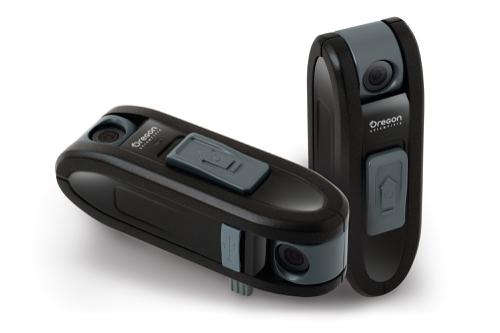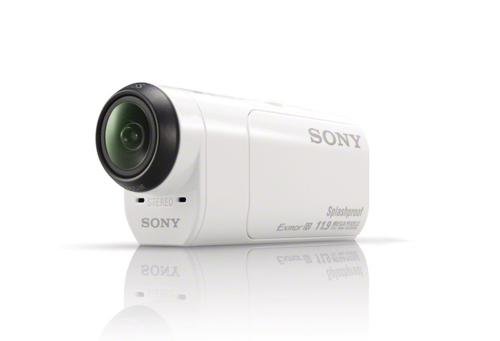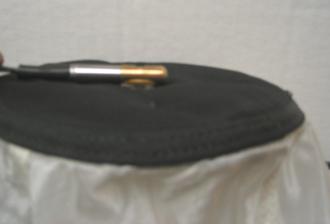Oregon Scientific ATC Chameleon Review
Eyes In The Back Of My Head.....
Remember when Mom told you she had "eyes in the back of her head?" With the Oregon Scientific Chameleon, she really could have em’!
Ever wanted to see what’s happening behind the camera? Without the hassle of two cameras, syncing in post, and splitting screens/picture in picture? With the new Oregon Scientific ATC Chameleon, syncrhonized video with two channels/angles in a single stream is quick and easy. The camera allows users to see what’s coming up and what’s gone by with just one button.
This camera is unique in that it features dual lenses, shooting two views to a single stream that may be displayed either side by side or over/under. This allows not only for POV, but reactions to the POV. The large button allows even the most thick mitten or glove to turn on/off the camera. Powering up the camera also starts record mode.
Note: See our comprehensive side-by-side shootout of the top POV Action Cameras here
Overview
At 4.5 x 1.5 x 2.25 inches, this slightly larger than average POV camera is a single-button on/record camera. The only user-selectable option on the camera is a switch that allows users to determine whether they’ll shoot over/under or side by side video. All in all, it’s incredibly simple.
The lenses are both 170 degree field of view lenses. In other words, they’re ruber-wide. Given that capturing action and POV reaction is the goal, they need to be wide, as they’re generally quite close to the subject on one end or the other. The lenses are pretty good on this low cost camera. Each lens can rotate 180 degrees; one rotates vertically, the other horizontally. The camera is not intended for shooting 3D content, as the two lenses cannot overlap or point at the same subject.
Mounting
The camera mount profile is somewhat higher than some of the other POV cameras; the dual V-clip mount may easily be removed for flush mounting. This will cover the microphone, but audio is rarely a priority in POV cameras. If for example, mounted directly to a helmet, mudflap, chest strap, or goggle strap, the mount is superflous, and the flush mount ability is likely preferable. Oregon Scientific offers several different mounting options such as ball mounts, flat mounts, adhesive mounts for surf, helmets, etc.
Recording Media
The ATC Chameleon stores files on a MicroSD, up to 32GB/Class 6 card. One minor observation; the recessed card slot housing makes it challenging for fat fingers to extract a card. The housing also offers a switch for camera status, a Micro USB port, and a switch for horizontal/vertical views.
Like most of its small-imager competitors, the Chameleon displays rolling shutter bending at very high shutter speeds. Keeping the camera reasonably horizontal in high light significantly reduces this phenomenon (in all POV cameras).
Codec
Like all other POV cameras, the Chameleon also uses the h.264/mp4 codec. It offers a slighly lower bitrate than other cameras; it’s 8Mpbs compared to other cameras at nearly double the bitrate. Like most POV cameras, this low bitrate/high compression is challenged in low light, but in high light and contrasted scenes it works quite well. Audio is a single channel AAC stream, and is similar in quality to most other POV cameras.
Output
The Chameleon offers two output resolutions; 1920 x 720, or 1280 by 1440 (yes, that figure is correct, taller than wide). Vertical mode applies 1280 x 720 to each channel, while horizontal mode is VGA per channel. Vertical mode provides for the best imagery in most instances. Vertical mode also allows very easy splits for full-screen views in any NLE system. This is the mode I recommend for most purposes.
Overall View
This camera is brilliant in design. Fast, easy to use, and offers a perspective that no other camera currently offers. Sure, one could purchase two separate POV cameras, have two separate streams, sync them in post, and have a similar result. However, it will cost twice as much and take twice as long, not to mention other variables. In this aspect, the Chameleon shines.
The low bitrate coupled with small imagers makes it a challenge in low light. Additionally, the codec will not open in every NLE or media player. For example, while the files will open in VLC, the Windows Media Player or Quicktime Basic will not open these files on a PC. Corel Videostudio will not open these files, while Adobe Premiere CS or Sony Vegas Pro/Movie Studio does properly decode these files.
This shot was taken post-sunset. The camera adds quite a bit of gain, shifting color and softening detail in very low light. This is similar to most POV cameras in its class. In this screengrab, the resolution/size shows 1280 x 1400 in over/under mode.
The split view denies either view the best quality image possible; this is inevitable and I cannot ding the camera for the way it chooses where to split the image. Again, the unique and creative nature of the split view makes up for this, however.
The creative views possible with this camera are unlimited. It is quite durable, can be dunked underwater (it is not waterproof for sustained periods of time, OS does offer a water housing), and is capable of drops from high areas. I dropped mine from approx 12’ and it was fine, even after landing on tarmac and impacting on the edge of the lens.
In this image, the compression causes contrast to bleed into highlights and shadows, softening the details in the image, However, as a B Roll and unique view, this won’t be an issue in most scenarios.
Post Production
As mentioned, not all NLE’s will properly decode this camera, but most should. Transcoding will be required for users of Final Cut Studio, while FCPX users will not need to transcode files from this camera.
The width of the lens is the same FOV as most popular POV cameras, so it will cut nicely into other POV cam content. Another option with 155-180 FOV content is that a negative spherize and crop filter may be applied to flatten out a too-wide image.
Expect to do some color correction. Bear in mind that two channels are now being corrected, so if lighting or color are dramatically different on one channel, the other will likely be adversely affected. It’s quite easy to split channels in any NLE for individual color correction. The standard AVC color correction process (Shift gamma, reduce yellow, pop sat) will help this camera really shine. A tiny bit of edge sharpening will benefit low contrast images (again, similar to other AVC-based camera files).
Summary
This camera has some terrific value for the budget-minded action-sport enthusiast. It also offers unique camera angles and an ease of use that is rare in the POV world. The angles alone make it a useful tool in any videographer’s tool box for walkthrus, capturing challenging angles, seeing around corners, capturing body positions while showing the environment, or just plain fun (I put one on a dog collar to capture the dogs ears and the wagging tail). The picture quality isn’t bad, the one-button record makes it ridiculously easy, and the price is definitely right. I’m happy to have a couple in my POV kit; they’ve come in handy already. If budget, a unique view, or simply another tool in the box are considerations, this is a terrific option.
Price:
$199.00 retail, available online or in sporting goods stores here.
For More Information
http://us.oregonscientific.com/cat-Outdoor-sub-Action-Cams-prod-ATC-Chameleon.html
For training on AVC or POV Cameras:
www.vasst.com
About The Author
DOUGLAS SPOTTED EAGLE is an audio and video pro. He is a Grammy recipient with DuPont, Peabody, and Telly awards lining his studio; he is also a participant/producer in multiple Emmy winning productions. Douglas is the Managing Producer for Sundance Media Group, Inc. and VASST, authoring several books and DVDs and serving as a trainer and consultant for videographers, software manufacturers and broadcasters. He is the author or co-author of several digital media titles including Digital Video Basics (VASST), The FullHD (VASST), and Vegas Editing Workshop (Focal Press) among many others. Douglas is an accomplished aerial photographer who thrives in the adrenaline-filled world of fast-action videography. He is active as a multimedia producer, trainer, and presenter, utilizing the latest technology as part of his workflow.






